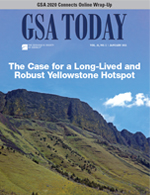Abstract View
Volume 31 Issue 1
(January 2021)
GSA Today
Article, pp. 4-10 | Full
Text |
PDF
The Case for a Long-Lived and Robust Yellowstone Hotspot
Victor E. Camp
San Diego State University, Dept. of Geological Sciences, 5500 Campanile Drive, San Diego,
California 92182, USA
Ray E. Wells
U.S. Geological Survey, 2130 SW 5th Street, Portland, Oregon 97201, USA
Abstract
The Yellowstone hotspot is recognized as a whole-mantle plume with a history that extends to at
least 56 Ma, as recorded by offshore volcanism on the Siletzia oceanic plateau. Siletzia
accreted onto the North American plate at 51–49 Ma, followed by repositioning of the Farallon
trench west of Siletzia from 48 to 45 Ma. North America overrode the hotspot, and it
transitioned from the Farallon plate to the North American plate from 42 to 34 Ma. Since that
time, it has been genetically associated with a series of aligned volcanic provinces associated
with age-progressive events that include Oligocene high-K calc-alkaline volcanism in the Oregon
backarc region with coeval adakite volcanism localized above the hot plume center; mid-Miocene
bimodal and flood-basalt volcanism of the main-phase Columbia River Basalt Group; coeval
collapse of the Nevadaplano associated with onset of Basin and Range extension and minor
magmatism; and late Miocene to recent bimodal volcanism along two coeval but antithetical
rhyolite migration trends—the Yellowstone–Snake River Plain hotspot track to the ENE and the
Oregon High Lava Plains to the WNW.
Manuscript received 21 July 2020. Revised manuscript received 14 Sept. 2020.
Manuscript accepted 17 Sept. 2020. Posted 16 Oct. 2020.
© The Geological Society of America, 2020. CC-BY-NC.
https://doi.org/10.1130/GSATG477A.1
Cover Image

Search Google Scholar for
Search GSA Today
